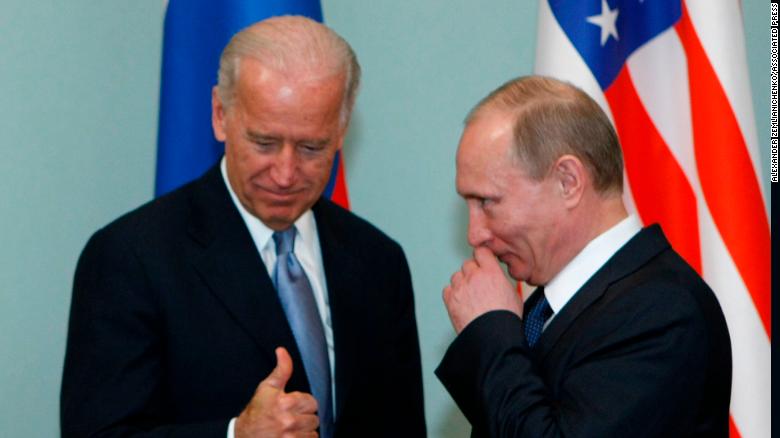President Vladimir Putin used some of his most direct language to date on Tuesday in his escalating standoff with the U.S. and its European allies. The Russian leader warned that if the U.S. and NATO do not halt what Moscow considers aggressive actions along the country’s border with Ukraine, Russia would respond in a “retaliatory military” manner.
“If the obviously aggressive line of our Western colleagues continues, we will take adequate, retaliatory military-technical measures [and] react toughly to unfriendly steps,” Putin told senior military officials during a meeting in remarks carried by Russian state TV. “I want to emphasize that we have every right to do so.”
Putin had previously spoken of his “red lines” on Ukraine — first and foremost his demand that the U.S. block Ukraine’s bid to become a NATO member. He had accused the West of crossing his red lines already, but the stern warning in Tuesday’s speech marked the first time he had personally warned of potential military action.
“They are doing whatever they want. But what they are doing now on the territory of Ukraine, or trying and planning to do, it is not a thousand kilometers from our national border, it is at our doorstep,” Putin said, lamenting that Russia had “nowhere to retreat.”
Speaking to CBS “Face the Nation” moderator Margaret Brennan on Monday, Vice President Kamala Harris reiterated the Biden administration’s support for Ukraine and warned that the U.S. and its allies were prepared to respond to any Russian incursion with harsh sanctions. The Biden administration has not ruled anything out in the standoff, but has not thus far said explicitly what level of assistance Ukraine could expect from Washington if Putin does attack.
U.S. officials say they believe Putin has not yet made up his mind about whether to do that.
“We are very clear that Russia should not invade the sovereignty of Ukraine, that we must stand up — and we are standing up — for its territorial integrity,” Harris told Brennan. “We are working with our allies in that regard, and we’ve been very clear that we are prepared to issue sanctions like you’ve not seen before.”
The vice president declined to say whether any new sanctions would target Putin directly, but noted that the administration and U.S. allies were in “direct conversations” with the Kremlin, and making their concerns and their own red lines well understood.
Assistant Secretary of State for European and Eurasian Affairs Dr. Karen Donfried, meanwhile, told reporters in a telephone briefing from Brussels on Tuesday morning that the U.S. was prepared to engage diplomatically through “multiple channels,” including bilateral engagement with Russia, through NATO talks with Moscow and through other regional blocs.
Donfried said bilateral engagement between the U.S. and Russia was likely to take place “in January,” but offered no further detail on where or between whom.
U.S. intelligence agencies raised the alarm weeks ago over Russia’s massing of troops near its border with Ukraine, spurring fear in Western capitals of a potential repeat of Putin’s 2104 invasion, which saw him annex the Crimean Peninsula away from the smaller neighboring nation.
American officials say Russia has massed about 100,000 troops near the Ukrainian border, but Moscow rejects all claims that it’s preparing for an attack as “fake news.”
Last week, Russia sent a formal, sweeping list of demands to the U.S., including that NATO cease its eastward expansion and reject any former Soviet country’s bid for membership, including Ukraine. Many analysts said the proposals were essentially a non-starter, and the White House has made it clear that membership in the transatlantic defense alliance is for applying nations and current members to decide, not Russia.
Following Putin’s recent video call with President Biden, the countries appointed working teams to meet and seek a way to ease the tension.
Russian Foreign Minister Sergey Lavrov noted that the relevant contacts were taking place and the U.S. had expressed “readiness” to engage in a dialogue with Russia. But Putin on Tuesday stressed that he would only accept “long-term, legally binding guarantees” from the U.S.
“You and I know well that even they, legal guarantees, cannot be trusted, because the U.S. easily withdraws from all international agreements it loses interest in for one reason or another while explaining it somehow or giving no explanations whatsoever,” Putin said. “Yet we need at least something, some legally binding agreements, not just verbal assurances. We know well the value of such assurances, words, and promises.”
Speaking at the same meeting, Defense Minister Sergey Shoigu said the U.S. had “deployed some 8,000 troops” near Russian borders and, along with NATO allies, held frequent exercises within the vicinity of Russia using strategic bomber aircraft. He also shared plans for the Russian Armed Forces to grow by nearly 15,000 regular forces and hold two largescale exercises next year.

